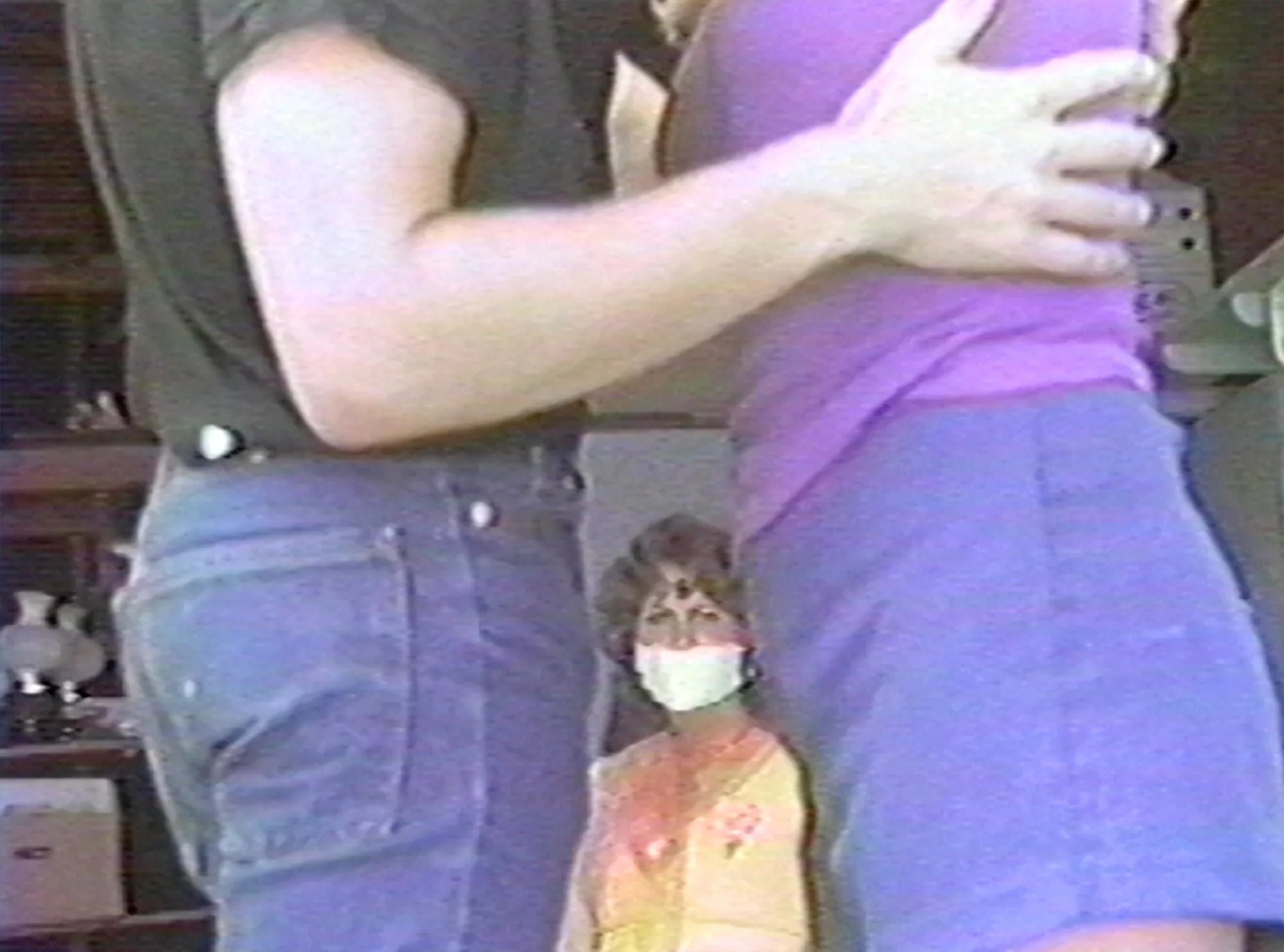Getting Rid of the Bodies: Examining James Robert Baker's Notions on Heterosexuality in Blonde Death
Note: This contains spoilers!
Tammy: So what are you in for?
Link: Eh, mass murder [...] just a bunch of rich scumbags, 19 in all. They had it coming.
Tammy: Wow, what did they do?
Link: Well, for starters, they’re a real bunch of pukes, you know… This guy had made his fortune selling torture phones to Latin American dictators, and his wife, she was just as bad. On the outside, she was beautiful as a model. But on the inside, she was a drooling ghoul into kiddie porn snuff films…
Tammy: So what’d you go to prison for then?
Link: They were good friends with the Reagans.
Look. I’m just gonna cut to the point: You should see Blonde Death.
Made by anarchist gay author James Robert Baker (as James Dillinger) for less than $2,000 as part of the EZTV collective—a digital art and video collective based in Los Angeles since 1983—Blonde Death follows innocent Mississippi teen Tammy Lynn Beaudorf on a journey of bisexual corruption and violent rampage.
Baker was a radical queer writer, a transgressive voice whose novel Tim and Pete (1993) drew such ire it effectively killed his writing career. He was dubbed “the world’s angriest gay man” by critics who opposed his depictions of radical violence against the American New Right. Whether that’s a fair characterization or not, anger certainly infuses the comedy of Blonde Death, animated by its critique and ultimate refusal of the structuring logic of heteronormativity in the US.
Heteronormativity, to lightly paraphrase Michael Warner and Lauren Berlant, encapsulates the “institutions, structures of understanding, and practical orientations” that not only organize heterosexuality as a sexual orientation but a privileged sexual orientation. In other words, if heterosexuality refers to the sexual/romantic coupling between a man and a woman (with all the baggage that entails), heteronormativity is a series of processes that produce and enforce the idea that heterosexuality 1) is the default and desired sexual orientation, and 2) has a promise of a particular future—a man and a woman meet, fall in love/have sex, get married, produce children, who then produce grandchildren, so on and so forth. Importantly, heteronormativity isn’t a stand-alone set of processes, but critically intertwined with other processes of power, like imperialism, racism, sexism, etc; it not only produces heterosexual privilege, but determines what kind of heterosexualit(ies) are privileged. In Blonde Death, heteronormativity manifests primarily through the suburban landscape, that “vast, mediocre expanse of Orange County” which serves as the antagonistic backdrop that traps Tammy in her abusive nuclear family.
Tammy represents a stereotypical All-American girl: Sweet, virginal, blonde. She suffers at the hands of her negligent and sexually threatening father Vern and cruel, fundamentalist Christian step-mother Clorette. In one early scene, which is genuinely unsettling in contrast to the film’s sharp humor, Clorette calls Tammy a whore and she snaps back. Her father then demands she “pull those panties down” to be spanked—and when Tammy refuses, he and Clorette grab her and force her across her dad’s lap, ignoring her desperate cries that she’s “too old to spank.” Vern later attempts to apologize by getting on his knees, clutching her waist and trying to kiss her exposed ass, literally, as Tammy shoves him off. This sequence sets up the constellation of oppressive forces Baker takes aim at: Not only is Vern the patriarchal head of the family, he is a government worker and thus a stand-in for US imperialism, which is, always, masculine and heterosexual; Clorette is a domineering evangelical force, who controls how Vern exercises his power. Maybe it’s a little on the nose to point out that fundamentalist Christianity has shaped how US American imperialism—internally and domestically—exercises force, but, well, I don’t think Baker was going for subtlety here.
Vern is then called away to Saudi Arabia and Clorette immediately abandons her step-daughter for a religious retreat. The absence of their oppressive force opens a wedge for Tammy to experience freedom outside of their dominant power structures, first in meeting the somewhat sexually aggressive, eye-patch wearing lesbian Gwen, and then in being taken hostage by—and ultimately seducing—her ex-convict, murderous boyfriend Link.
Gwen and Link as foils both challenge in various ways the heteronormative logic of the suburban landscape Tammy is trapped within. To do away, again, with subtlety, Gwen is a deviant sexual figure, whose comedically over the top attempts to seduce Tammy into lesbianism are constantly undermined by Tammy’s cartoonish obliviousness. On the other hand, Link and Tammy’s initial meeting seems to follow a more heteronormative logic: Link takes Tammy hostage at gunpoint, only for her to fall in love with him. Subsequently, they have sex. But, their heterosexual coupling is not a recuperation—it does not put Tammy and Link back on the path of heteronormativity, safely away from Gwen’s influence. Instead, Link’s intrusion into her life reveals to Tammy the danger heteronormativity obscures, quite literally, as he foils Clorette’s attempt to poison her and proves to Tammy finally that her nuclear family is not a protective force but in fact the very thing that will kill her.
Link and Tammy’s heterosexual status is further undone by the arrival of Link’s former prison boyfriend, Troy, who promptly attempts to insert himself into their relationship (as he suggests, in maybe my favorite line, a “menage-a-twat”). Link’s initial refusal underlines the impositional force of suburbia as representative of oppressive logic: “That was Fulsom [the prison], this is Orange County.” If Link and Tammy’s relationship is deviant, it is an acceptable deviance, liable to be subsumed back within the suburban order—get rid of the bodies, get married, have children, settle down. In other words, for most of the film, they still have an out. Accepting Troy would mean fully turning away from that assumed heterosexual future—in Fulsom, gay sex is okay, because the prison operates outside of the structure of the free-world. In Orange County, though? Gay sex is the ultimate threat to order, more so than murder, more so than sexual abuse. In fact, the imagined threat of gay sex almost breaks Tammy and Link up, as Tammy, who had no problem instantly falling in love with a dude who held a pistol to her head, struggles with the idea that he’s bisexual. That Tammy’s discovery of Link and Troy, ahem, “wrestling,” follows on the heels of Tammy fleeing from Gwen’s increasingly aggressive sexual advances, after watching her assault her ex-husband, is certainly not a coincidence.
Link/Troy/Tammy’s menage-a-twat and the trail of bodies in their wake feels hauntingly familiar, like finding the missing puzzle piece that completes a puzzle’s border. In “‘Out to See Video: EZTV’s Queer Microcinema in West Hollywood,” Julia Bryan-Wilson notes that Blonde Death was the first “real hit” from EZTV, playing in their screening space for “four months straight due to popular demand” (70). At the Weird Wednesday screening, the introduction by Bleeding Skull folks noted Baker’s influence on cult queer filmmakers like Gregg Araki and Jon Moritsugu. It’s easy to see those influences in the particular flavor of queer anarchist rebellion, say, Araki’s Teenage Apocalypse trilogy, alongside the irreverently political humor. But traces of Blonde Death can be felt even in more contemporary, mainstream queer films, whether in direct reference or having filtered through these films' New Queer Cinema predecessors. In Zelda Williams and Diablo Cody’s 2024 release, Lisa Frankenstein, for example, Lisa’s antagonistic, fundamentalist step-mother feels so very much like Clorette. That’s not to say Blonde Death necessarily originated the tropes it deploys, but queer film history is, by its nature, shaky and difficult to clearly map. Films like Blonde Death were made on the edges (or entirely away from) the mainstream film industry, on tiny budgets, with limited releases and preservation. For every Kenneth Anger, there’s twenty filmmakers whose work we might never get to see without being in the right place at the right time.
Blonde Death is a treasure. It’s hilarious and furious, grappling with the complex intersections of power, set against the backdrop of Reagan’s 1980s. It has some of the funniest dialogue I’ve ever heard. If you’re someone even remotely interested in queer film history, put Blonde Death at the top of your list.





remus is a cartoonist and phd candidate at the university of florida, living in austin. their favorite movie is cats (2019). unironically. you can find them on letterboxd @threewolfmoons